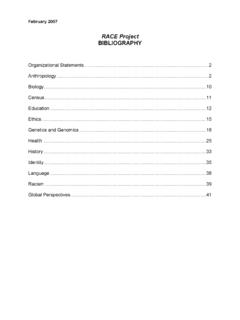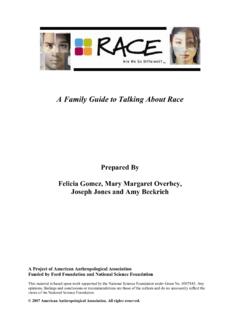Transcription of THE HISTORY OF THE IDEA OF RACE… AND WHY IT MATTERS
1 2007 by the American Anthropological Association. All rights reserved. 1 This paper was presented at the conference Race, Human Variation and Disease: Consensus and Frontiers, sponsored by the American Anthropological Association (AAA) and funded by the Ford Foundation. The conference, an activity of AAA s public education project RACE funded by the Ford Foundation and the National Science Foundation, was held March 14-17, 2007 in Warrenton, Virginia. This paper represents the views of the author and not the AAA RACE Project. THE HISTORY OF THE IDEA OF AND WHY IT MATTERS Audrey Smedley Professor of Anthropology Emerita Virginia Commonwealth University The position taken by many anthropologists, both biological and social, and increasingly many other scholars in the social sciences is that race is a cultural construct.
2 It should be clear that this is not a definition or even a characterization of race, but an assertion about the scholarly or existential domain in which we can best examine and explain the phenomenon of race. Race should be analyzed as a social/cultural reality that exists in a realm independent of biological or genetic variations. No amount of research into the biophysical or genetic features of individuals or groups will explain the social phenomenon of race. When five white policemen shot a young unarmed African immigrant 41 times in the doorway of his New York apartment, this can t be explained by examining their genes or biology. Nor can we explain employer preferences for white job applicants or discrimination in housing or any other of the social realities of racism by references to human biological differences.
3 This does not mean that we deny that there is a biological basis for some human behaviors at the individual level which is a perfectly legitimate perspective for those who are engaged in this kind of research. Nor does it mean that the existence of race as a cultural phenomenon has no impact on the biology of human beings. On the contrary we know a lot about the sometimes devastating effects of race and racism on the biology and behavior of individuals and groups. Because of several hundred years of racism, during which both physical and psychological oppression have characterized the lives and environments of those people seen as members of low status races, differences in health status and life styles among them have appeared and continue to impact all of us.
4 The significance of HISTORY . In the middle of the 20th century, a new generation of historians began to take another look at the beginnings of the American experience. They spent decades exploring all of the original 2007 by the American Anthropological Association. All rights reserved. 2 documents relating to the establishment of colonies in america . What these scholars discovered was to transform the writing of American HISTORY forever. Their research revealed that our 19th and 20th century ideas and beliefs about races did not in fact exist in the 17th century. Race originated as a folk idea and ideology about human differences; it was a social invention, not a product of science.
5 Historians have documented when, and to a great extent, how race as an ideology came into our culture and our consciousness. This is the story that I will briefly tell here. (One of the first of the publications and perhaps the one with the greatest impact was a book by Edmund Morgan entitled, American Slavery, American Freedom [1975]. It is the detailed story of Virginia, the first successful colony. On its publication it was hailed as a classic that has inspired numerous other historians.) The establishment of Jamestown in Virginia by English colonists occurred 400 years ago this year, in 1607. From the beginning, Jamestown was a crude, rough, and turbulent community of mostly young Englishmen who came to seek their fortunes and return home.
6 They planned to emulate the Spanish; to obtain wealth by conquering and enslaving the native peoples, and forcing them to produce gold and silver. However, the Indians didn t take well to slavery; many died of European diseases and others escaped to unknown territories. Also there was no gold and silver immediately available; but settlers soon discovered a crop, tobacco, whose trade would bring them wealth. But growing and processing tobacco required very hard work. The greatest problem the colonists constantly faced was lack of labor; many settlers would not or could not do such intensive work. Within a decade, the colony began to import indentured servants, mostly from England, and it was this pattern of servitude that provided a model for the slavery that was to come later.
7 Servants were bought and sold, ill-fed, ill-clothed, and poorly-housed. They were punished cruelly for petty crimes. Mortality was high, but the surplus poor emigrating from England in the early 17th century had few choices. If they survived the period of debenture, usually 4-7 years in the New World, they could be set free, allowed to acquire land and servants, and to make their fortunes for themselves. However, there were many degrees of servitude; and most did not survive. In 1619, the first Africans arrived. There has been some debate about who they were, but we know that they had Spanish or Portuguese names and were already familiar with European culture. In the US it is widely and popularly believed that the colonists brought Africans to the New World as slaves from the beginning and that Europeans were naturally prejudiced toward Africans because of their physical characteristics, specifically dark skin.
8 Historians now hold that true slavery did not exist in the early decades of the English North 2007 by the American Anthropological Association. All rights reserved. 3 American colonies (see Allen 1997, Fredrickson 2002, E. Morgan 1975, P. Morgan 1998, Parent, Jr. 2003, among others). Englishmen were unfamiliar with the institution. They saw their society as a free one, based on free labor, and believed that English laws had terminated all forms of slavery centuries before their arrival in the Americas. But they were familiar with many forms of bond servitude which they saw as unfree labor, and some men who purchased headrights to laborers treated them as if they were slaves for life.
9 Masters were often brutal; they flogged servants for disobedience, or cut off their ears, or put skewers through their tongues. But the settlers were also callous and cruel toward one another. Often servants were called slaves, and a distinction between servitude and slavery was not at all clear. Consequently, the first Africans who arrived in Jamestown were not initially or uniformly perceived as slaves (Parent 2003). They were assimilated into the colony as laborers under varying contracts like those of Europeans. Some Africans worked off their debts and became freedmen. A few ambitious men obtained land and livestock, built substantial houses, married, and established themselves as well-to-do planters.
10 Some became entrepreneurs and engaged in trading and other commercial activities and had business dealings on an equal footing with whites. One famous family, that of Anthony Johnson and his two sons owned more than 440 acres of land; they also had headrights for, (that is, owned) three Africans, three Europeans and two Indians as servants. They exercised the same rights as propertied Europeans. They participated in the assembly, the governing body of the colony, voted, served on juries, and socialized with white planters. Like their white counterparts, free black property owners were often contemptuous of government, arrogant and insulting toward those considered their social inferiors, assertive of their rights, and prone to fighting.







